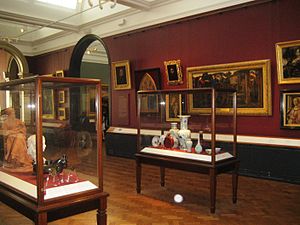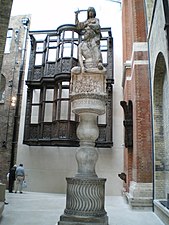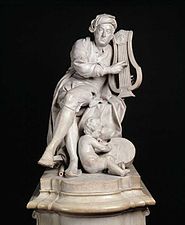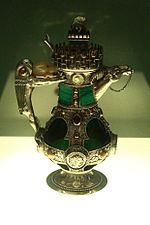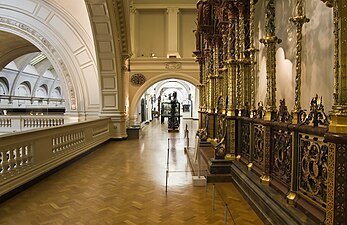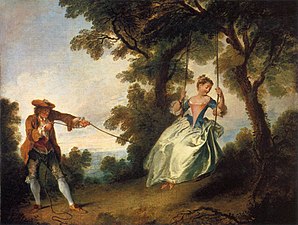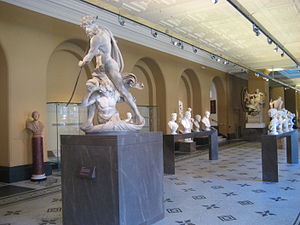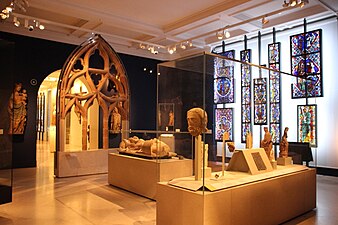Victoria and Albert Museum
C1 | |
| Website | https://www.vam.ac.uk |
|---|---|
The Victoria and Albert Museum (abbreviated V&A) in
The V&A is located in the
The V&A covers 12.5 acres (5.1 ha)
The museum owns the world's largest collection of post-
Since 2001 the museum has embarked on a major £150m renovation programme. The new European galleries for the 17th century and the 18th century were opened on 9 December 2015. These restored the original Aston Webb interiors and host the European collections 1600–1815.[5][6] The Young V&A in east London is a branch of the museum, and a new branch in London – V&A East – is being planned.[7] The first V&A museum outside London, V&A Dundee opened on 15 September 2018.[8]
History
Foundation


The Victoria and Albert Museum has its origins in
By February 1854 discussions were underway to transfer the museum to the current site[12] and the museum was renamed South Kensington Museum. In 1855 the German architect Gottfried Semper, at the request of Cole, produced a design for the museum, but it was rejected by the Board of Trade as too expensive.[13] The current site was occupied by Brompton Park House, which was extended in 1857 to include the first refreshment rooms. The V&A was the first museum in the world to provide researchers and guests a catering service.[14]
The official opening by Queen Victoria was on 20 June 1857.[15] In the following year, late-night openings were introduced, made possible by the use of gas lighting. In the words of museum director Cole gas lighting was introduced "to ascertain practically what hours are most convenient to the working classes".[16] To raise interest for the museum among the target audience, the museum exhibited its collections on both applied art and science. The museum aimed to provide educational resources and thus boost the productive industry.[17]
In these early years the practical use of the collection was very much emphasised as opposed to that of "High Art" at the

Queen Victoria returned to lay the foundation stone of the Aston Webb building (to the left of the main entrance) on 17 May 1899.[20] It was during this ceremony that the change of name from 'South Kensington Museum' to 'Victoria and Albert Museum' was made public. Queen Victoria's address during the ceremony, as recorded in The London Gazette, ended: "I trust that it will remain for ages a Monument of discerning Liberality and a Source of Refinement and Progress."[21]
The exhibition which the museum organised to celebrate the centennial of the 1899 renaming, A Grand Design, first toured in North America from 1997 (Baltimore Museum of Art, Museum of Fine Arts, Boston, Royal Ontario Museum, Toronto, Museum of Fine Arts, Houston and the Fine Arts Museums of San Francisco), returning to London in 1999.[22] To accompany and support the exhibition, the museum published a book, Grand Design, which it has made available for reading online on its website.[23]
1900–1950
The opening ceremony for the Aston Webb building by
In 1939 on the outbreak of the Second World War, most of the collection was sent to a quarry in Wiltshire, to Montacute House in Somerset, or to a tunnel near Aldwych tube station, with larger items remaining in situ, sand-bagged and bricked in.[26] Between 1941 and 1944 some galleries were used as a school for children evacuated from Gibraltar.[27] The South Court became a canteen, first for the Royal Air Force and later for Bomb Damage Repair Squads.[27]
Before the return of the collections after the war, the
Since 1950

In July 1973 as part of its outreach programme to young people, the V&A became the first museum in Britain to present a rock concert. The V&A presented a combined concert/lecture by the British progressive folk-rock band Gryphon, who explored the lineage of medieval music and instrumentation and related how those contributed to contemporary music 500 years later. This innovative approach to bringing young people to museums was a hallmark of the directorship of Sir Roy Strong and was subsequently emulated by some other British museums.
In the 1980s Strong renamed the museum as "The Victoria and Albert Museum, the National Museum of Art and Design". Strong's successor Elizabeth Esteve-Coll oversaw a turbulent period for the institution in which the museum's curatorial departments were re-structured, leading to public criticism from some staff. Esteve-Coll's attempts to make the V&A more accessible included a criticised marketing campaign emphasising the café over the collection.
In 2001 the museum embarked on a major £150m renovation programme, called the "FuturePlan".[30][31] The plan involves redesigning all the galleries and public facilities in the museum that have yet to be remodelled. This is to ensure that the exhibits are better displayed, more information is available, access for visitors is improved, and the museum can meet modern expectations for museum facilities.[32] A planned Spiral building was abandoned; in its place a new Exhibition Road Quarter designed by Amanda Levete's AL_A was created.[33] It features a new entrance on Exhibition Road, a porcelain-tiled courtyard (inaugurated in 2017 as the Sackler Courtyard and renamed the Exhibition Road Courtyard in 2022)[34] and a new 1,100-square-metre underground gallery space (the Sainsbury Gallery) accessed through the Blavatnik Hall. The Exhibition Road Quarter project provided 6,400 square metres of extra space, which is the largest expansion at the museum in over 100 years.[35] It opened on 29 June 2017.[36]
In March 2018, it was announced that the
The museum also runs the Young V&A at Bethnal Green, which reopened on 1 July 2023;[40] it used to run Apsley House, and also the Theatre Museum in Covent Garden. The Theatre Museum is now closed; the V&A Theatre Collections are now displayed within the South Kensington building.
Architecture

Victorian parts of the building have a complex history, with piecemeal additions by different architects. Founded in May 1852, it was not until 1857 that the museum moved to its present site. This area of London, previously known as Brompton, had been renamed 'South Kensington'. The land was occupied by Brompton Park House, which was extended, most notably by the "Brompton Boilers",[41] which were starkly utilitarian iron galleries with a temporary look and were later dismantled and used to build the V&A Museum of Childhood. The first building to be erected that still forms part of the museum was the Sheepshanks Gallery in 1857 on the eastern side of the garden.[42] Its architect was civil engineer Captain Francis Fowke, Royal Engineers, who was appointed by Cole.[43] The next major expansions were designed by the same architect, the Turner and Vernon galleries built in 1858–1859[44] to house the eponymous collections (later transferred to the Tate Gallery) and now used as the picture galleries and tapestry gallery respectively. The North[45] and South Courts[46] were then built, both of which opened by June 1862. They now form the galleries for temporary exhibitions and are directly behind the Sheepshanks Gallery. On the very northern edge of the site is situated the Secretariat Wing;[47] also built in 1862, this houses the offices and boardroom, etc. and is not open to the public.
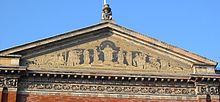
An ambitious scheme of decoration was developed for these new areas: a series of
Part of these galleries became the new galleries covering the 19th century, opened in December 2006. The last work by Fowke was the design for the range of buildings on the north and west sides of the garden. This includes the refreshment rooms, reinstated as the Museum Café in 2006, with the silver gallery above (at the time the ceramics gallery); the top floor has a splendid lecture theatre, although this is seldom open to the general public. The ceramic staircase in the northwest corner of this range of buildings was designed by F. W. Moody[51] and has architectural details of moulded and coloured pottery. All the work on the north range was designed and built in 1864–69. The style adopted for this part of the museum was Italian Renaissance; much use was made of terracotta, brick and mosaic. This north façade was intended as the main entrance to the museum, with its bronze doors, designed by James Gamble and Reuben Townroe, having six panels, depicting Humphry Davy (chemistry); Isaac Newton (astronomy); James Watt (mechanics); Bramante (architecture); Michelangelo (sculpture); and Titian (painting); The panels thus represent the range of the museum's collections.[52] Godfrey Sykes also designed the terracotta embellishments and the mosaic in the pediment of the North Façade commemorating the Great Exhibition, the profits from which helped to fund the museum. This is flanked by terracotta statue groups by Percival Ball.[53] This building replaced Brompton Park House, which could then be demolished to make way for the south range.

The interiors of the three refreshment rooms were assigned to different designers. The Green Dining Room (1866–68) was the work of
With the death of Captain Francis Fowke of the Royal Engineers, the next architect to work at the museum was Colonel (later Major General) Henry Young Darracott Scott,[59] also of the Royal Engineers. He designed to the northwest of the garden the five-storey School for Naval Architects (also known as the science schools),[60] now the Henry Cole Wing, in 1867–72. Scott's assistant J. W. Wild designed the impressive staircase[61] that rises the full height of the building. Made from Cadeby stone, the steps are 7 feet (2.1 m) in length, while the balustrades and columns are Portland stone. It is now used to jointly house the prints and architectural drawings of the V&A (prints, drawings, paintings and photographs) and Royal Institute of British Architects (RIBA Drawings and Archives Collections), and the Sackler Centre for arts education, which opened in 2008.[62]

Continuing the style of the earlier buildings, various designers were responsible for the decoration. The terracotta embellishments were again the work of Godfrey Sykes, although sgraffito was used to decorate the east side of the building designed by F. W. Moody.[63] A final embellishment was the wrought iron gates made as late as 1885 designed by Starkie Gardner.[64] These lead to a passage through the building. Scott also designed the two Cast Courts (1870–73)[65] to the southeast of the garden (the site of the "Brompton Boilers"); these vast spaces have ceilings 70 feet (21 m) in height to accommodate the plaster casts of parts of famous buildings, including Trajan's Column (in two separate pieces). The final part of the museum designed by Scott was the Art Library and what is now the sculpture gallery on the south side of the garden, built in 1877–1883.[66] The exterior mosaic panels in the parapet were designed by Reuben Townroe, who also designed the plaster work in the library.[67] Sir John Taylor designed the bookshelves and cases.[67] This was the first part of the museum to have electric lighting.[68] This completed the northern half of the site, creating a quadrangle with the garden at its centre, but left the museum without a proper façade. In 1890 the government launched a competition to design new buildings for the museum, with architect Alfred Waterhouse as one of the judges;[69] this would give the museum a new imposing front entrance.
Edwardian period
The main façade, built from red brick and Portland stone, stretches 720 feet (220 m) along Cromwell Gardens and was designed by Aston Webb after winning a competition in 1891 to extend the museum. Construction took place between 1899 and 1909.[70] Stylistically it is a strange hybrid: although much of the detail belongs to the Renaissance, there are medieval influences at work. The main entrance, consisting of a series of shallow arches supported by slender columns and niches with twin doors separated by the pier, is Romanesque in form but Classical in detail. Likewise, the tower above the main entrance has an open work crown surmounted by a statue of fame,[71] a feature of late Gothic architecture and a feature common in Scotland, but the detail is Classical. The main windows to the galleries are also mullioned and transomed, again a Gothic feature; the top row of windows are interspersed with statues of many of the British artists whose work is displayed in the museum.
Prince Albert appears within the main arch above the twin entrances, and Queen Victoria above the frame around the arches and entrance, sculpted by Alfred Drury. These façades surround four levels of galleries. Other areas designed by Webb include the Entrance Hall and Rotunda, the East and West Halls, the areas occupied by the shop and Asian Galleries, and the Costume Gallery. The interior makes much use of marble in the entrance hall and flanking staircases, although the galleries as originally designed were white with restrained classical detail and mouldings, very much in contrast to the elaborate decoration of the Victorian galleries, although much of this decoration was removed in the early 20th century.[72]
-
North side of Garden, by Captain Francis Fowke, Royal Engineers, 1864–1869
-
Western Cast Court, by Henry Young Darracott Scott, 1870–1873
-
The Art Library, by Scott and other designers, 1877–1883
-
Main Entrance, by Aston Webb, 1899–1909
Post-war period

The museum survived the Second World War with only minor bomb damage. The worst loss was the Victorian stained glass on the Ceramics Staircase, which was blown in when bombs fell nearby; pockmarks still visible on the façade of the museum were caused by fragments from the bombs.
In the immediate post-war years, there was little money available for other than essential repairs. The 1950s and early 1960s saw little in the way of building work; the first major work was the creation of new storage space for books in the Art Library in 1966 and 1967. This involved flooring over Aston Webb's main hall to form the book stacks,[73] with a new medieval gallery on the ground floor (now the shop, opened in 2006). Then the lower ground-floor galleries in the south-west part of the museum were redesigned, opening in 1978 to form the new galleries covering Continental art 1600–1800 (late Renaissance, Baroque through Rococo and neo-Classical).[74] In 1974 the museum had acquired what is now the Henry Cole wing from the Royal College of Science.[75] To adapt the building as galleries, all the Victorian interiors except for the staircase were recast during the remodelling. To link this to the rest of the museum, a new entrance building was constructed on the site of the former boiler house, the intended site of the Spiral, between 1978 and 1982.[76] This building is of concrete and very functional, the only embellishment being the iron gates by Christopher Hay and Douglas Coyne of the Royal College of Art.[76] These are set in the columned screen wall designed by Aston Webb that forms the façade.
Recent years
A few galleries were redesigned in the 1990s including the Indian, Japanese, Chinese, ironwork, the main glass galleries, and the main silverware gallery, which was further enhanced in 2002 when some of the Victorian decoration was recreated. This included two of the ten columns having their ceramic decoration replaced and the elaborate painted designs restored on the ceiling. As part of the 2006 renovation the mosaic floors in the sculpture gallery were restored—most of the Victorian floors were covered in linoleum after the Second World War. After the success of the British Galleries, opened in 2001, it was decided to embark on a major redesign of all the galleries in the museum; this is known as "FuturePlan", and was created in consultation with the exhibition designers and masterplanners Metaphor. The plan is expected to take about ten years and was started in 2002. To date several galleries have been redesigned, notably, in 2002: the main Silver Gallery, Contemporary; in 2003: Photography, the main entrance, The Painting Galleries; in 2004: the tunnel to the subway leading to South Kensington tube station, new signage throughout the museum, architecture, V&A and RIBA reading rooms and stores, metalware, Members' Room, contemporary glass, and the Gilbert Bayes sculpture gallery; in 2005: portrait miniatures, prints and drawings, displays in Room 117, the garden, sacred silver and stained glass; in 2006: Central Hall Shop, Islamic Middle East, the new café, and sculpture galleries. Several designers and architects have been involved in this work. Eva Jiřičná designed the enhancements to the main entrance and rotunda, the new shop, the tunnel and the sculpture galleries. Gareth Hoskins was responsible for contemporary and architecture, Softroom, Islamic Middle East and the Members' Room, McInnes Usher McKnight Architects (MUMA) were responsible for the new Cafe and designed the new Medieval and Renaissance galleries which opened in 2009.[77]
Garden

The central garden was redesigned by Kim Wilkie and opened as the
At night both the planters and the water feature may be illuminated, and the surrounding façades lit to reveal details normally in shadow. Especially noticeable are the mosaics in the
Exhibition Road Quarter

In 2011 the V&A announced that London-based practice
The Exhibition Road Quarter opened in 2017, with a new entrance providing access for visitors from Exhibition Road. A new courtyard, the Sackler Courtyard, has been created behind the Aston Webb Screen, a colonnade built in 1909 to hide the museum's boilers. The colonnade was kept but the wall in the lower part was removed in the construction to allow public access to the courtyard.[81] The new 1,200-square meter courtyard is the world's first all-porcelain courtyard,[36] which is covered with 11,000 handmade porcelain tiles in fifteen different linear patterns glazed in different tone. A pavilion of Modernist design with glass walls and an angular roof covered with 4,300 tiles is located at the corner and contains a cafe.[35] Skylights on the courtyard provide natural light for the stairwell and the exhibition space located below the courtyard created by digging 15m into the ground. The Sainsbury Gallery's column-less space at 1,100 square metres is one of the largest in the country, providing space for temporary exhibitions. The gallery can be assessed through the existing Western Range building where a new entrance to the Blavatnik Hall and the museum has been created, and visitors can descend into the gallery via stairs with lacquered tulipwood balustrades.[35][82][83]
Collections
The collecting areas of the museum are not easy to summarize, having evolved partly through attempts to avoid too much overlap with other national museums in London. Generally, the classical world of the West and the Ancient Near East is left to the British Museum, and Western paintings to the National Gallery, though there are all sorts of exceptions—for example, painted portrait miniatures, where the V&A has the main national collection.
The Victoria & Albert Museum is split into four curatorial departments: Decorative Art and Sculpture; Performance, Furniture, Textiles and Fashion; Art, Architecture, Photography and Design; and Asia.[84] The museum curators care for the objects in the collection and provide access to objects that are not currently on display to the public and scholars.
The collection departments are further divided into sixteen display areas, whose combined collection numbers over 6.5 million objects, not all items are displayed or stored at the V&A. There is a repository at Blythe House, West Kensington, as well as annex institutions managed by the V&A,[85] also the museum lends exhibits to other institutions. The following lists each of the collections on display and the number of objects within the collection.
| Collection | Number of items |
|---|---|
| Architecture (annex of the RIBA) | 2,050,000 |
| Asia | 160,000 |
| British Galleries (cross department display) | ... |
| Ceramics | 74,000 |
| Childhood (annex of the V&A) | 20,000 |
| Design, Architecture and Digital | 800 |
| Fashion & Jewellery | 28,000 |
| Furniture | 14,000 |
| Glass | 6,000 |
| Metalwork | 31,000 |
| Paintings & Drawings | 202,500 |
| Photography | 500,000 |
| Prints & Books | 1,500,000 |
| Sculpture | 17,500 |
| Textiles | 38,000 |
| Theatre (includes V&A Theatre Collections Reading Room, an annexe of the former Theatre Museum) | 1,905,000 |
The museum has 145 galleries, but given the vast extent of the collections, only a small percentage is ever on display. Many acquisitions have been made possible only with the assistance of the
Architecture
In 2004, the V&A alongside Royal Institute of British Architects opened the first permanent gallery in the UK[86] covering the history of architecture with displays using models, photographs, elements from buildings and original drawings. With the opening of the new gallery, the RIBA Drawings and Archives Collection has been transferred to the museum, joining the already extensive collection held by the V&A. With over 600,000 drawings, over 750,000 papers and paraphernalia, and over 700,000 photographs from around the world, together they form the world's most comprehensive architectural resource.
Not only are all the major British architects of the last four hundred years represented, but many European (especially Italian) and American architects' drawings are held in the collection. The RIBA's holdings of over 330 drawings by
As well as
In June 2022, the RIBA announced it would be terminating its 20-year partnership with the V&A in 2027, "by mutual agreement", ending the permanent architecture gallery at the museum. Artefacts will be transferred back to the RIBA's existing collections, with some rehoused at the institute's headquarters at 66 Portland Place building, set to become a new House of Architecture following a £20 million refurbishment.[97]
Asia

The V&A's collection of Art from Asia numbers more than 160,000 objects, one of the largest in existence. It has one of the world's most comprehensive and important collections of Chinese art whilst the collection of South Asian Art is the most important in the West. The museum's coverage includes items from South and South East Asia, Himalayan kingdoms, China, the Far East and the Islamic world.
Islamic art
The V&A holds over 19,000 items from the Islamic world, ranging from the early Islamic period (the 7th century) to the early 20th century. The Jameel Gallery of Islamic Art, opened in 2006, houses a representative display of 400 objects with the highlight being the
South Asia

The museum's collections of South and South-East Asian art are the most comprehensive and important in the West comprising nearly 60,000 objects, including about 10,000 textiles and 6,000 paintings,
East Asia
The Far Eastern collections include more than 70 works of art
The
The smaller galleries cover Korea, the Himalayan kingdoms and South East Asia. Korean displays include green-glazed ceramics, silk embroideries from officials' robes and gleaming boxes inlaid with mother-of-pearl made between 500 AD and 2000. Himalayan items include important early Nepalese bronze sculptures, repoussé work and embroidery. Tibetan art from the 14th to the 19th century is represented by notable 14th- and 15th-century religious images in wood and bronze, scroll paintings and ritual objects. Art from Thailand, Burma, Cambodia, Indonesia and Sri Lanka in gold, silver, bronze, stone, terracotta and ivory represents these rich and complex cultures, the displays span the 6th to 19th centuries. Refined Hindu and Buddhist sculptures reflect the influence of India; items on the show include betel-nut cutters, ivory combs and bronze palanquin hooks.
-
Bodhisattva Maitreya, Gandhara, Pakistan, Kusana Dynasty, 2nd-4th century AD
-
Image depicting Lord Parshvanatha, India, 7th Century
-
Image depicting Lord Rishabhanatha dated 9th century, India
-
10th-century, Rock crystal ewer
-
Jain Goddess Ambika, Odisha, India, 12th century
-
Japanese Incense Burner, Signed 'Dai Nippon, Koko Sei', Patinated bronze inlaid with gilt bronze and other soft metal alloys c. 1877
-
Betel container, 19th century, Filigree work in gold on a gold ground, outlined with bands of rubies and imitation emeralds, Mandalay, Burma
Books
The museum houses the National Art Library, a public library[102] containing over 750,000 books, photographs, drawings, paintings, and prints. It is one of the world's largest libraries dedicated to the study of fine and decorative arts. The library covers all areas and periods of the museum's collections with special collections covering illuminated manuscripts, rare books and artists' letters and archives.
The library consists of three large public rooms, with around a hundred individual study desks. These are the West Room, Centre Room and Reading Room. The centre room contains 'special collection material'.
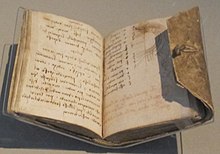
One of the great treasures in the library is the Codex Forster, one of
Writers whose papers are in the library are as diverse as
The National Art Library (also called Word and Image Department) at the Victoria and Albert Museum collection catalogue used to be kept in different formats including printed exhibit catalogues, and card catalogues. A computer system called MODES cataloguing system was used from the 1980s to the 1990s, but those electronic files were not available to the library users. All of the archival material at the National Art Library is using Encoded Archival Description (EAD). The Victoria and Albert Museum has a computer system but most of the items in the collection, unless those were newly accessioned into the collection, probably do not show up in the computer system. There is a feature on the Victoria and Albert Museum website called "Search the Collections," but not everything is listed there.[108]
The National Art Library also includes a collection of comics and comic art. Notable parts of the collection include the Krazy Kat Arkive, comprising 4,200 comics, and the Rakoff Collection, comprising 17,000 items collected by writer and editor Ian Rakoff.[109]
The Victoria and Albert Museum's Word and Image Department was under the same pressure being felt in archives around the world, to digitise their collection. A large scale digitisation project began in 2007 in that department. That project was entitled the Factory Project to reference Andy Warhol and to create a factory to completely digitise the collection. The first step of the Factory Project was to take photographs using digital cameras. The Word and Image Department had a collection of old photos but they were in black and white and in variant conditions, so new photos were shot. Those new photographs will be accessible to researchers to the Victoria and Albert Museum web-site. 15,000 images were taken during the first year of the Factory Project, including drawings, watercolors, computer-generated art, photographs, posters, and woodcuts. The second step of the Factory Project is to catalogue everything. The third step of the Factory Project is to audit the collection. All of those items which were photographed and catalogued, must be audited to make sure everything listed as being in the collection was physically found during the creation of the Factory Project. The fourth goal of the Factory Project is conservation, which means performing some basic preventable procedures to those items in the department. There is a "Search the Collections" feature on the Victoria and Albert web-site. The main impetus behind the large-scale digitisation project called the Factory Project was to list more items in the collections in those computer databases.[108]
-
BLW Manuscript Book of Hours, about 1480–1490
-
BLW Qur'an
British galleries
These fifteen galleries—which opened in November 2001—contain around 4,000 items. The displays in these galleries are based around three major themes: "Style", "Who Led Taste" and "What Was New". The period covered is 1500 to 1900, with the galleries divided into three major subdivisions:
- Restoration and Baroquestyles
- Gothic Revival
- Victorian Britain, 1837–1901, covering the later phases of the Gothic Revival, French influences, Classical and Renaissance revivals, Aestheticism, Japanese style, the continuing influence of China, India, and the Islamic world, the Arts and Crafts movement and the Scottish School.
Not only the work of British artists and craftspeople is on display, but also work produced by European artists that was purchased or commissioned by British patrons, as well as imports from Asia, including porcelain, cloth and wallpaper. Designers and artists whose work is on display in the galleries include
The galleries showcase a number of complete and partial reconstructions of period rooms, from demolished buildings, including:
- The parlour from 2 Henrietta Street, London, dated 1727–1728, designed by James Gibbs
- The Norfolk House Music Room,[110] St James Square, London, dated 1756, designed by Matthew Brettingham and Giovanni Battista Borra
- A section of a wall from the Glass Drawing-Room of Northumberland House, dated 1773–1775, designed by Robert Adam
Some of the more notable works displayed in the galleries include:
- Pietro Torrigiani's coloured terracotta bust of Henry VII, dated 1509–1511
- Henry VIII's writing desk, dated 1525, made from walnut and oak, lined with leather and painted and gilded with the king's coat of arms
- A Elizabeth I
- The Great Bed of Ware, dated 1590–1600, a large, elaborately carved four-poster bed with marquetry headboard
- Gianlorenzo Bernini's bust of Thomas Baker, from the 1630s
- 17th-century tapestries from the Sheldon and Mortlake Tapestry Works
- The wood relief of The Stoning of St Stephen, dated c. 1670, by Grinling Gibbons
- The Macclesfield Wine Set, dated 1719–1720, made by Anthony Nelme, the only complete set known to survive.
- The life-size sculpture of George Frederick Handel, dated 1738, by Louis-François Roubiliac
- Furniture by Thomas Chippendale and Robert Adam
- The sculpture of Bashaw, dated 1831–1834, by Matthew Cotes Wyatt[111]
- Aesthetic and Arts & Crafts furniture by Edward William Godwin[112] and Charles Rennie Mackintosh;[113] and carpets and interior textiles by William Morris.
The galleries also link design to wider trends in British culture. For instance, design in the Tudor period was influenced by the spread of printed books and the work of European artists and craftsmen employed in Britain. In the Stuart period, increasing trade, especially with Asia, enabled wider access to luxuries like carpets, lacquered furniture, silks and porcelain. In the Georgian age there was an increasing emphasis on entertainment and leisure. For example, the increase in tea drinking led to the production of tea paraphernalia such as china and caddies. European styles are seen on the Grand Tour also influenced taste. As the Industrial Revolution took hold, the growth of mass production produced entrepreneurs such as Josiah Wedgwood, Matthew Boulton and Eleanor Coade. In the Victorian era new technology and machinery had a significant effect on manufacturing, and for the first time since the reformation, the Anglican and Roman Catholic Churches had a major effect on art and design such as the Gothic Revival. There is a large display on the Great Exhibition which, among other things, led to the founding of the V&A. In the later 19th century, the increasing backlash against industrialisation, led by John Ruskin, contributed to the Arts and Crafts movement.
-
Henry VIII's writing box
-
Howard Grace Cup
-
Great Bed of Ware, one of the largest beds of the world
-
Norfolk House Music Room
-
Wedgwood Portland Vase
Cast courts
One of the most dramatic parts of the museum is the Cast Courts in the sculpture wing, comprising two large, skylighted rooms two storeys high housing hundreds of plaster casts of sculptures, friezes and tombs. One of these is dominated by a full-scale replica of Trajan's Column, cut in half to fit under the ceiling. The other includes reproductions of various works of Italian Renaissance sculpture and architecture, including a full-size replica of Michelangelo's David. Replicas of two earlier Davids by Donatello and Verrocchio, are also included, although for conservation reasons the Verrocchio replica is displayed in a glass case.
The two courts are divided by corridors on both storeys, and the partitions that used to line the upper corridor (the Gilbert Bayes sculpture gallery) were removed in 2004 to allow the courts to be viewed from above.
-
San Petronio Basilica, Bologna by Jacopo della Quercia
-
Cathedral of Santiago de Compostela
-
Cast Court—Plaster copy of Trajan's Column
-
Room 46b; Cast Court—Plaster Cast of David and The Slave, by Michelangelo
-
Cast Court post-2014 restoration
Ceramics and glass

This is the largest and most comprehensive ceramics and glass collection in the world, with over 80,000 objects from around the world. Every populated continent is represented. Apart from the many pieces in the Primary Galleries on the ground floor, much of the top floor is devoted to galleries of ceramics of all periods covered, which include display cases with a representative selection, but also massed "visible storage" displays of the reserve collection.
Well represented in the collection is

Many famous potters, such as Josiah Wedgwood,
The glass collection covers 4000 years of glassmaking, and has over 6000 items from Africa, Britain, Europe, America and Asia. The earliest glassware on display comes from Ancient Egypt and continues through the Ancient Roman, Medieval, Renaissance covering areas such as
The main gallery was redesigned in 1994, the glass balustrade on the staircase and mezzanine are the work of Danny Lane, the gallery covering contemporary glass opened in 2004 and the sacred silver and stained-glass gallery in 2005. In this latter gallery stained glass is displayed alongside silverware starting in the 12th century and continuing to the present. Some of the most outstanding stained glass, dated 1243–1248 comes from the Sainte-Chapelle, is displayed along with other examples in the new Medieval & Renaissance galleries. The important 13th-century glass beaker known as the Luck of Edenhall is also displayed in these galleries. Examples of British stained glass are displayed in the British Galleries. One of the most spectacular items in the collection is the chandelier by Dale Chihuly in the rotunda at the museum's main entrance.
-
Flower pyramid, Delft, c. 1695
-
Jardinière (plant pot), Vincennes porcelain, France; 1750–53
-
The Luck of Edenhall, glass beaker, Syria, 13th century
-
Stained glass panel, depicting Christ's resurrection, Germany, c. 1540–42
Contemporary
These galleries are dedicated to temporary exhibits showcasing both trends from recent decades and the latest in design and fashion.
Prints and drawings
Prints and drawings from the over 750,000 items in the collection can be seen on request at the
The print collection has more than 500,000 items, covering: posters, greetings cards, bookplates, as well as a comprehensive collection of old master prints from the Renaissance to the present, including works by Rembrandt, William Hogarth, Giovanni Battista Piranesi, Canaletto, Karl Friedrich Schinkel, Henri Matisse and Sir William Nicholson.
Fashion
The costume collection is the most comprehensive in Britain, containing over 14,000 outfits plus accessories, mainly dating from 1600 to the present. Costume sketches, design notebooks, and other works on paper are typically held by the Word and Image department. Because everyday clothing from previous eras has not generally survived, the collection is dominated by fashionable clothes made for special occasions. One of the first significant gifts of the costume came in 1913 when the V&A received the Talbot Hughes collection containing 1,442 costumes and items as a gift from Harrods following its display at the nearby department store.
Some of the oldest items in the collection are medieval
In 1971,
In 1999, V&A began a series of live catwalk events at the museum titled Fashion in Motion featuring items from historically significant fashion collections. The first show featured
In 2002, the museum acquired the Costiff collection of 178
The V&A runs an ongoing textile and dress conservation programme. For example, in 2008, an important but heavily soiled, distorted and water-damaged 1954 Dior outfit called 'Zemire' was restored to displayable condition for the Golden Age of Couture exhibition.[125]
-
1770s sack-back gown
-
c. 1870 wedding dress
-
1912 Lucile evening dress
-
1954 Dior evening gown called 'Zemire'
-
[126]"Mantua gown made from an ivory silk brocaded in a pattern of stylised flowers and leaves."
The V&A Museum has a large collection of shoes around 2000 pairs from different cultures around the world. The collection shows the chronological progression of shoe height, heel shape and materials, revealing just how many styles we consider to be modern have been in and out of fashion across the centuries. [127]
Furniture
In November 2012, the museum opened its first gallery to be exclusively dedicated to furniture.
The furniture collection, while covering Europe and America from the Middle Ages to the present, is predominantly British, dating between 1700 and 1900.[130] Many of the finest examples are displayed in the British Galleries, including pieces by Chippendale, Adam, Morris, and Mackintosh.[131] One of the oldest items is a chair leg from Middle Egypt dated to 200-395AD.[128][132]
The Furniture and Woodwork collection also includes complete rooms, musical instruments, and clocks. Among the rooms owned by the museum are the Boudoir of Madame de Sévilly (Paris, 1781–82) by Claude Nicolas Ledoux, with painted panelling by Jean Simeon Rousseau de la Rottière;[133] and Frank Lloyd Wright's Kaufmann Office, designed and constructed between 1934 and 1937 for the owner of a Pittsburgh department store.[134]
The collection includes pieces by William Kent,
The Soulages collection of Italian and French Renaissance objects was acquired between 1859 and 1865, and includes several
There are a set of beautiful inlaid doors, dated 1580 from
One of the oldest clocks in the collection is an astronomical clock of 1588 by Francis Nowe. One of the largest is James Markwick the younger's
-
Baumhauer, Joseph—Commode, with panels of Japanese lacquer & vernis martin, French, 1760–65
-
The Evelyn Cabinet—Inlaid with panels of Florentine pietre dure; Italy, 1644–46
-
Cabinet on stand, German, c. 1580
Jewellery
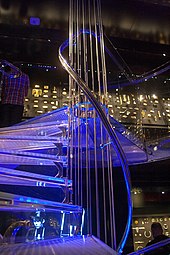
The museum's jewellery collection, containing over 6000 items is one of the finest and most comprehensive collections of jewellery in the world and includes works dating from
-
Spanish gold and emerald pendant
Metalwork

This collection of more than 45,000 items covers decorative ironwork, both wrought and cast, bronze, silverware, arms and armour, pewter, brassware and enamels (including many examples Limoges enamel). The main iron work gallery was redesigned in 1995.
There are over 10,000 objects made from silver or gold in the collection, the display (about 15 percent of the collection) is divided into secular
Silversmiths whose work is represented in the collection include Paul Storr[140] (whose Castlereagh Inkstand, dated 1817–1819, is one of his finest works) and Paul de Lamerie.[141]
The main iron work gallery covers European wrought and cast iron from the medieval period to the early 20th century. The master of wrought ironwork Jean Tijou is represented by both examples of his work and designs on paper. One of the largest items is the Hereford Screen,[142] weighing nearly 8 tonnes, 10.5 metres high and 11 metres wide, designed by Sir George Gilbert Scott in 1862 for the chancel in Hereford Cathedral, from which it was removed in 1967. It was made by Skidmore & Company. Its structure of timber and cast iron is embellished with wrought iron, burnished brass and copper. Much of the copper and ironwork is painted in a wide range of colours. The arches and columns are decorated with polished quartz and panels of mosaic.
One of the rarest items in the collection is the 58 cm-high
-
The Becket Casket, the most elaborate, the largest and possibly the earliest Becket reliquary, Limoges enamel, c. 1180–90
-
The Burghley Nef—Silver-gilt salt cellar, France, 1527–28
-
The Gloucester Candlestick, a masterpiece of English metalwork, c. 1110
-
Tabernacle, Cologne, Germany, c. 1180
Musical instruments
Musical instruments are classified as furniture by the museum,[145] although Asian instruments are held by their relevant departments.[146]
Among the more important instruments owned by the museum are a violin by
The Musical Instruments gallery closed on 25 February 2010,[151] a decision that was highly controversial.[145] An online petition of over 5,100 names on the Parliamentary website led to Chris Smith asking in Parliament about the future of the collection.[152] The answer, from Bryan Davies, was that the museum intended to preserve and care for the collection and keep it available to the public, with items being redistributed to the British Galleries, the Medieval & Renaissance Galleries, and the planned new galleries for Furniture and Europe 1600–1800, and that the Horniman Museum and other institutions were possible candidates for loans of material to ensure that the instruments remained publicly viewable.[152] The Horniman went on to host a joint exhibition with the V&A of musical instruments,[153] and has the loan of 35 instruments from the museum.[154]
Paintings (and miniatures)
The collection includes about 1130 British and 650 European
19th-century British artists are well represented. John Constable and J. M. W. Turner are represented by oil paintings, watercolours and drawings. One of the most unusual objects on display is Thomas Gainsborough's experimental showbox with its back-lit landscapes, which he painted on glass, which allowed them to be changed like slides. Other landscape painters with works on display include Philip James de Loutherbourg, Peter De Wint and John Ward.
In 1857 John Sheepshanks donated 233 paintings, mainly by contemporary British artists, and a similar number of drawings to the museum with the intention of forming a 'A National Gallery of British Art', a role since taken on by
Richard Ellison's collection of 100 British watercolours was given by his widow in 1860 and 1873 'to promote the foundation of the National Collection of Water-Color Paintings'. Over 500 British and European oil paintings, watercolours and miniatures and 3000 drawings and prints were bequeathed in 1868–1869 by the clergymen Chauncey Hare Townshend and Alexander Dyce.
Several French paintings entered the collection as part of the 260 paintings and miniatures (not all the works were French, for example
Another major Victorian benefactor was
The Salting Bequest of 1909 included, among other works, watercolours by J. M. W. Turner. Other watercolourists include:
There is a copy of Raphael's The School of Athens over 4 metres by 8 metres in size, dated 1755 by Anton Raphael Mengs on display in the eastern Cast Court.
Miniaturists represented in the collection include Jean Bourdichon, Hans Holbein the Younger, Nicholas Hilliard, Isaac Oliver, Peter Oliver, Jean Petitot, Alexander Cooper, Samuel Cooper, Thomas Flatman, Rosalba Carriera, Christian Friedrich Zincke, George Engleheart, John Smart, Richard Cosway and William Charles Ross.
-
Portrait of a Lady known as Smeralda Brandini, 1470-1475
-
Rembrandt—The Departure of the Shunammite Woman, c. 1640
-
Tintoretto—Self-Portrait as a Young Man, c. 1548
-
Raphael—The Miraculous Draught of Fishes, 1515
-
Raphael—St Paul Preaching in Athens, 1515
Photography
The collection contains more than 500,000 images dating from the advent of photography, the oldest image dating from 1839. The gallery displays a series of changing exhibits and closes between exhibitions to allow full re-display to take place. Already in 1858, when the museum was called the South Kensington Museum, it had the world's first international photographic exhibition.
The collection includes the work of many photographers from
One of the more unusual collections is that of Eadweard Muybridge's photographs of Animal Locomotion of 1887, this consists of 781 plates. These sequences of photographs taken a fraction of a second apart capture images of different animals and humans performing various actions. There are several of John Thomson's 1876-7 images of Street Life in London in the collection. The museum also holds James Lafayette's society portraits, a collection of more than 600 photographs dating from the late 19th to early 20th centuries and portraying a wide range of society figures of the period, including bishops, generals, society ladies, Indian maharajas, Ethiopian rulers and other foreign leaders, actresses, people posing in their motor cars and a sequence of photographs recording the guests at the famous fancy-dress ball held at Devonshire House in 1897 to celebrate Queen Victoria's diamond jubilee.
In 2003 and 2007 Penelope Smail and Kathleen Moffat generously donated Curtis Moffat's extensive archive to the museum. He created dynamic abstract photographs, innovative colour still-lives and glamorous society portraits during the 1920s and 1930s. He was also a pivotal figure in Modernist interior design. In Paris during the 1920s, Moffat collaborated with Man Ray, producing portraits and abstract photograms or "rayographs".
Sculpture

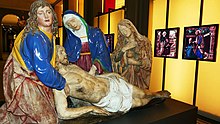

The sculpture collection at the V&A is the most comprehensive holding of post-classical European sculpture in the world. There are approximately 22,000 objects
The collection of Italian, Medieval, Renaissance, Baroque and Neoclassical sculpture (both original and in cast form) is unequalled outside of Italy. It includes
An unusual sculpture is the ancient Roman statue of Narcissus restored by Valerio Cioli c. 1564 with plaster. There are several small scale bronzes by Donatello such as
There are also several Renaissance works by Northern European sculptors in the collection including work by: Veit Stoss, Tilman Riemenschneider, Hendrick de Keyser, Hans Daucher and Peter Flötner. Baroque works from the same area include the work of Adriaen de Vries and Sébastien Slodtz. The Spanish sculptors with work in the collection include Alonso Berruguete and Luisa Roldán represented by her Virgin and Child with St Diego of Alcala c. 1695.
Sculptors, both British and European, who were based in Britain and whose work is in the collection include, and Eric Gill. A sample of some of these sculptors' work is on display in the British Galleries.
With the opening of the Dorothy and
Smaller-scale works are displayed in the Gilbert Bayes gallery, covering medieval especially English alabaster sculpture, bronzes, wooden sculptures and has demonstrations of various techniques such as bronze casting using lost-wax casting.
The majority of the Medieval and Renaissance sculpture is displayed in the new Medieval and Renaissance galleries (opened December 2009).
One of the largest objects in the collection is the
-
rilievo schiacciato
-
Andrea della Robbia—Adoration of the Magi
-
Claude Michel (Clodion)—Cupid and Psyche, in Terracotta
-
Canova—Theseus
Textiles
The collection of textiles consists of more than 53,000 examples, mainly western European though all populated continents are represented, dating from the 1st century AD to the present, this is the largest such collection in the world. Techniques represented include weaving, printing, quilting embroidery, lace, tapestry and carpets. These are classified by technique, countries of origin and date of production. The collections are well represented in these areas: early silks from the Near East, lace, European tapestries and English medieval church embroidery.
The tapestry collection includes a fragment of the Cloth of St Gereon, the oldest known surviving European tapestry. A highlight of the collection is the four
One of the earliest surviving examples of European quilting, the late 14th-century Sicilian Tristan Quilt, is also held by the collection. The collection has numerous examples of various types of textiles designed by William Morris,[163] including, embroidery, woven fabrics, tapestries (including The Forest tapestry of 1887), rugs and carpets, as well as pattern books and paper designs. The art deco period is covered by rugs and fabrics designed by Marion Dorn. From the same period there is a rug designed by Serge Chermayeff.
The collection also includes the Oxburgh Hangings, which were made by Mary, Queen of Scots and Bess of Hardwick.[164] However, the Oxburgh Hangings are on permanent long-term loan at Oxburgh Hall.[164]
-
Mille FleurTapestry, Flemish, 16th-century Flemish
-
Devonshire Hunting Tapestries, Detail of the Boar and Bear Hunt, Netherlands, mid-15th century
-
Azerbaijani carpet "Barda" (First variant - "Chelebi"),[165]Karabakh group. 19th-century
Theatre and performance
The V&A holds the national collection of performing arts in the UK, including drama, dance, opera, circus, puppetry, comedy, musical theatre, costume, set design, pantomime, popular music and other forms of live entertainment.[166]
The Theatre & Performance collections were founded in the 1920s when private collector, Gabrielle Enthoven, donated her collection of theatrical memorabilia to the V&A. In 1974 two further independent collections were compiled to form a comprehensive performing arts collection at the V&A.[167] The collections were displayed at the Theatre Museum, which operated from Covent Garden until closing in 2007.[168] Theatre & Performance galleries opened at South Kensington in March 2009 [169] tracing the production process of performance and include a temporary exhibition space. Types of items displayed include costumes, set models, wigs, prompt books, and posters.
The department holds significant archives documenting current practice and the history of performing arts. These include the English Stage Company at the Royal Court Theatre, D'Oyly Carte and the design collection of the Arts Council. Notable personal archives include Vivien Leigh, Peter Brook, Henry Irving and Ivor Novello.
Rock and pop are well represented with the Glastonbury Festival archive,[170] Harry Hammond photographic collection[171] and Jamie Reid archive documenting punk. Costumes include those worn by John Lennon, Mick Jagger, Elton John, Adam Ant, Chris Martin, Iggy Pop, Prince, Shirley Bassey and the stage outfit worn by Roger Daltrey at Woodstock.[172]
Departments
Education
The education department
Several areas of the collection have dedicated study rooms, these allow access to items in the collection that are not currently on display, but in some cases require an appointment to be made.[174]
The new Sackler education suite, occupying the two lower floors of the Henry Cole Wing opened in September 2008. This includes lecture rooms and areas for use by schools, which will be available during school holidays for use by families, and will enable direct handling of items from the collection.
V&A Publishing
V&A Publishing, within the education department, works to raise funds for the museum by publishing around 30 books and digital items each year. The company has around 180 books in print.[175]
Activities for children
Activity backpacks are available for children. These are free to borrow and include hands-on activities such as puzzles, construction games and stories related to themes of the museum.[176]
Activities for adults
The Learning Academy offers adult courses as well as training for professionals in the culture and heritage sector, both nationally and internationally. We also have great facilities in which to teach, study and get closer to our collections.[177]
Research and conservation
Research[178] is a very important area of the museum's work, and includes: identification and interpretation of individual objects; other studies contribute to systematic research, this develops the public understanding of the art and artefacts of many of the great cultures of the world; visitor research and evaluation to discover the needs of visitors and their experiences of the museum. Since 1990, the museum has published research reports;[179] these focus on all areas of the collections.
Conservation[180] is responsible for the long-term preservation of the collections, and covers all the collections held by the V&A and the V&A Museum of Childhood. The conservators specialise in particular areas of conservation. Areas covered by the conservator's work include "preventive" conservation this includes: performing surveys, assessments and providing advice on the handling of items, correct packaging, mounting and handling procedures during movement and display to reduce risk of damaging objects. Activities include controlling the museum environment (for example, temperature and light) and preventing pests (primarily insects) from damaging artefacts. The other major category is "interventive" conservation, this includes: cleaning and reintegration to strengthen fragile objects, reveal original surface decoration, and restore shape. Interventive treatment makes an object more stable, but also more attractive and comprehensible to the viewer. It is usually undertaken on items that are to go on public display.
National Art Library
The National Art Library merged with the Prints, Paintings and Drawings department to form the Word and Image Department, which serves curatorial staff of the museum.[181] The library and its reading rooms are located on the second floor of the V&A, though some collections, particularly Archives, are held off-site.[182]
Partnerships

The V&A works with a small number of partner organisations in Sheffield, Dundee and Blackpool to provide a regional presence.[183][184]
The V&A discussed with the
Plans for a new gallery in Blackpool are also under consideration.
The V&A is one of 17 museums across Europe and the Mediterranean participating in a project called Discover Islamic Art. Developed by the Brussels-based consortium
The museum is a
Exhibitions
The V&A has large galleries devoted to temporary exhibitions. A typical year will see more than a dozen different exhibitions being staged, covering all areas of the collections. Notable exhibitions of recent years have been:
- Britain Can Make It, 1946
- Hats: An Anthology, 2009
- Power of Making, 2011[194]
- Food: Bigger Than the Plate, 2019[195]
- Concealed Histories: Uncovering the Story of Nazi Looting, 2019 - 2021
The V&A came second in London's top paid exhibitions in 2015 with the record-breaking Alexander McQueen show (3,472 a day).[196]
Controversies
In November 2019 the art photographer Nan Goldin led a "die-in" in the Sackler courtyard entrance of the museum, in protest against the V&A's acceptance of donations from the Sackler family, which owned Purdue Pharma, makers of the addictive opioid painkiller OxyContin.[197] The museum's director, Tristram Hunt, defended the museum's relationship with the Sacklers, saying it was proud to have received support from the family over a number of years.[198]
Also in 2019 the V&A received sponsorship for an exhibition on cars from Bosch, which had been fined 90 million euro over its part in the diesel emissions scandal. A V&A spokeswoman said: "Bosch is at the forefront of innovation, with a focus on delivering sustainable solutions for the mobility of the future."[199]
Extinction Rebellion staged a dirty protest outside the V&A Dundee, in protest against Barclays Bank's sponsorship of the museum's Mary Quant exhibition.[200]
In 2021 plans to cut the museum's costs by reorganising its collections by date rather than by material were abandoned after critics said it would lead to staff cuts and thereby a loss of expertise.[201]
Media
Starting in March 2020 BBC Two transmitted a series of six programmes depicting the back-stage work of the curators and restorers of the museum, entitled Secrets of the Museum.[202]
The Sculpture Gallery featured in the 2023 romantic comedy Red, White & Royal Blue.[203][204][205]
Galleries
- General views
Museum galleries
Asia
British galleries
-
Pietro Torrigiani's bust of Henry VII
-
Jacket and portrait of Margaret Laton, about 1610, no. T.228-1994
-
Honoré Pelle's bust of Charles II
-
James II's wedding suit
-
Grinling Gibbons's Stoning of Saint Stephen
-
Stoke Edith hanging
-
Dressing equipage
-
Robert Adam ceiling from the Adelphi
-
Panels from the Glass Drawing Room Northumberland House
-
Pugin armoire
-
William Burges decanter
-
Minton fountain
-
Sideboard, 1867–1870, Edward William Godwin (1833–80) V&A Museum no. CIRC.38:1 to 5-1953
Metalwork
-
Metalwork gallery, 1st floor
-
George Gilbert Scott—Screen from Hereford Cathedral, 1862
Paintings
-
John Constable—View of Salisbury Cathedral, 1823
-
J. M. W. Turner—Venice from the Giudecca, 1840
French paintings
-
Nicolas Lancret—The Swing, 1735
-
Jean François de Troy—The Alarm, or the Gouvernante Fidèle, 1723
Italian paintings
-
Luca Carlevarijs— Two Studies of Men, c. 1700–1710
-
Pietro Perugino— The Nativity; the Virgin, Saint Joseph and the Shepherds adoring the Infant Christ
-
Giovanni Battista Tiepolo— St Leo in Glory
Sculptures
-
Auguste Rodin—Age of Bronze, 1877
-
Canova—The Three Graces, 1814–1817
-
Room 22—Sculpture 1600–1870,Canova—Theseus and the Minotaur
-
Sculpture Gallery
-
Room 24—Sculpture 1600–1870
-
Bust of Oliver Cromwell
Gothic Art
See also
- List of most visited art museums
- Director of the Victoria and Albert Museum
- Philippa Glanville
- V&A Digital Futures events on digital art
- List of design museums
References
- ^ "British Museum is the most-visited UK attraction again". BBC News. Retrieved 18 March 2024.
- ISSN 0261-3077. Retrieved 13 January 2017.
- ^ "V&A About us". Victoria and Albert Museum.
- ^ "FuturePlan: Victoria and Albert Museum". vam.ac.uk. 6 May 2011. Retrieved 12 May 2011.
- ^ "'Our Europe is an inclusive Europe': the Victoria and Albert Museum's new European Galleries". Apollo. 4 December 2015.
- Victoria & Albert Museum. Archived from the originalon 8 December 2015.
- ^ "V&A East". Victoria and Albert Museum. Retrieved 21 July 2022.
- ^ a b c Moore, Rowan (15 September 2018). "V&A Dundee review – a flawed treasure house on the Tay". The Guardian. Retrieved 16 September 2018.
- OCLC 558942717.
- ^ Sheppard, F.H.W. (1975). Survey of London XXXVIII: The Museums Area of South Kensington and Westminster. p. 248.
- ^ Physick 1982, p. 19.
- ^ Physick 1982, p. 22.
- ^ Harry Francis Gottfried Semper: Architect of the Nineteenth Century 1996 Mallgrave p. 226
- ^ Physick 1982, p. 30.
- ^ "Queen Victoria's Journals – Information Site". qvj.chadwyck.com.
- ^ Physick 1982, p. 35.
- ^ a b Sheppard 1975, p. 248.
- ^ Sheppard 1975, p. 97.
- ^ Sheppard 1975, p. 252.
- ^ Physick 1982, p. 252.
- ^ "No. 27081". The London Gazette. 19 May 1899. p. 3186.
- ^ "A Grand Design: The Art of the Victoria and Albert Museum". ArtMag.com.
- ^ "A Grand Design: A History of the Victoria and Albert Museum". Victoria and Albert Museum. 29 July 2015.
- ^ Physick 1982, p. 246.
- ^ Sheppard 1975, p. 254.
- ^ Physick 1982, p. 269.
- ^ a b Physick 1982, p. 270.
- ^ "Designing Britain – BCMI Introduction". Vads.ahds.ac.uk. 20 December 2002. Archived from the original on 15 May 2011. Retrieved 12 May 2011.
- ^ a b Banham, Mary; Hillier, Bevis, eds. (1976). A Tonic to the Nation: The Festival of Britain 1951. London: Thames & Hudson. p. 58.
- ^ "ARTS | V&A to have £150m facelift". BBC News. 18 April 2002. Retrieved 12 May 2011.
- ^ "Completed FuturePlan projects". V&A.
- ^ "FuturePlan". V&A.
- ^ Lusiardi, Federica (27 April 2016). "The renovated V&A by Amanda Levete Architects". inexhibit. Retrieved 19 March 2017.
- ^ Thorpe, Vanessa; Walters, Joanna (1 October 2022). "V&A drops financial ties with Sackler family over links with opioids". The Guardian. Retrieved 12 March 2023.
- ^ a b c Mairs, Jessica (28 June 2017). "AL_A completes tile-covered entrance and subterranean gallery for London's V&A museum". Dezeen.
- ^ a b "Duchess of Cambridge 'quite stunned' by world's first all-porcelain courtyard at V&A Museum". The Telegraph. 29 June 2020. Archived from the original on 12 January 2022.
- ^ "Kensington Palace on Twitter". Twitter. Retrieved 26 March 2018.
- ^ "V&A Dundee opens its doors to the world". BBC. 15 September 2018.
- ^ "Everything you need to know about the V&A Dundee". BBC. 12 September 2018.
- ^ Charman, Helen (March 2023). "Young V&A – Countdown to Summer 2023". Victoria and Albert Museum. Retrieved 12 March 2023.
- ^ Physick 1982, p. 23.
- ^ Physick 1982, p. 33.
- ^ "Victoria and Albert Museum: Quadrangle". Royal Institute of British Architects. Archived from the original on 7 April 2012. Retrieved 16 December 2010.
- ^ Physick 1982, p. 39.
- ^ Physick 1982, p. 47.
- ^ Physick 1982, p. 53.
- ^ Physick 1982, p. 92.
- ^ Physick 1982, p. 62.
- ^ Physick 1982, p. 71.
- ^ Flores, Carol A. Hrvol, Owen Jones: Design, Ornament, Architecture and Theory in an Age in Transition, 2006, p. 94.
- ^ Physick 1982, p. 124.
- ^ Physick 1982, p. 120.
- ^ Physick 1982, p. 118.
- ^ Physick 1982, p. 131.
- ^ Physick 1982, p. 133.
- ^ Physick 1982, p. 135.
- ^ Catalogue of the Drawings Collection of the RIBA: Alfred Stevens, Susan Beattie 1975
- ^ Physick 1982, p. 139.
- ^ Cherry, Bridget, and Nikolaus Pevsner, The Buildings of England London 3: North West, 1991, p. 496.
- ^ Physick 1982, p. 146.
- ^ Physick 1982, p. 148.
- ^ "Sackler Centre for arts education at the V&A". Victoria and Albert Museum. Archived from the original on 16 May 2010. Retrieved 16 December 2010.
- ^ Physick 1982, p. 151.
- ^ Physick 1982, p. 155.
- ^ Physick 1982, p. 156.
- ^ Physick 1982, p. 172.
- ^ a b Physick 1982, p. 174.
- ^ Physick 1982, p. 175.
- ^ "Victoria and Albert Museum: Competition to complete the museum". Royal Institute of British Architects. Archived from the original on 8 September 2012. Retrieved 16 December 2010.
- ^ A. Stuart Gray, Edwardian Architecture: A Biographical Dictionary, 2nd edition, 1988, p. 374.
- ^ Physick 1982, p. 228.
- ^ Cherry and Pevsner, The Buildings of England London 3: The North West, 1991, p. 495.
- ^ Physick 1982, p. 274.
- ^ Physick 1982, p. 273.
- ^ Physick 1982, p. 276.
- ^ a b Physick 1982, p. 277.
- ^ "Completed Projects – Victoria and Albert Museum". vam.ac.uk. 5 May 2011. Archived from the original on 9 October 2011. Retrieved 12 May 2011.
- ^ "AL_A win V&A Exhibition Road project – Dezeen". dezeen.com. 28 March 2011.
- ^ "V&A museum Exhibition Road extension by AL_A – Dezeen". dezeen.com. 11 July 2012.
- ^ "Elsewhere: London: The Millennium Projects: Museum Expansions". www.thecityreview.com.
- ^ Fraser, Alice (10 February 2017). "Aston Webb Screen Reveal". V&A.
- ^ Woodman, Ellis (28 June 2017). "The V&A's new £48m Exhibition Road Quarter is a triumph – review". The Telegraph. Archived from the original on 12 January 2022.
- ^ Moore, Rowan (2 July 2017). "Exhibition Road Quarter: the V&A digs deep". The Observer.
- ^ "Curator of Photography Job Description". vam.ac.uk. Retrieved 12 October 2021.
- ^ V&A Collecting Plan Including Acquisition & Disposal Policy, August 2004.
- ^ "About the V&A and RIBA Architecture Partnership Collections – Victoria and Albert Museum". vam.ac.uk. 6 May 2011. Archived from the original on 28 May 2010. Retrieved 12 May 2011.
- ^ Lewis, Douglas, The Drawings of Andrea Palladio, 2nd edition, 2000.
- ^ Coope, Rosalys, Catalogue of the Drawings Collection of the RIBA: Jacques Gentilhatre, 1972.
- ^ McAndrew, John, Catalogue of the Drawings Collection of the RIBA: Antonio Visentini, 1974.
- ^ Harris, John, and Gordon Higgott, Inigo Jones Complete Architectural Drawings, 1989.
- ^ Alister Rowan, Catalogues of Architectural Drawings in the V&A: Robert Adam, 1988.
- ^ Snodin, Michael (ed.), Catalogues of Architectural Drawings in the V&A: Sir William Chambers, 1996.
- ^ De la Ruffuniere du Prey, Pierre, Catalogues of Architectural Drawings in the V&A: Sir John Soane, 1985.
- ^ Wedgwood, Alexandra, Catalogues of Architectural Drawings in the V&A: A. W. N. Pugin and the Pugin Family, 1985.
- ^ "109. The window from Sir Paul Pindar's House, Bishopsgate. [image 400x556 pixels]". Fromoldbooks.org. Retrieved 12 May 2011.
- ^ "Image – V&A". vam.ac.uk. 13 January 2011. Retrieved 12 May 2011.
- ^ Waite, Richard (7 June 2022). "RIBA and V&A rip up 20-year-old deal to showcase architecture collection". Architects' Journal. Retrieved 7 June 2022.
- ^ a b "About the Collection – Victoria and Albert Museum". vam.ac.uk. 8 March 2004. Archived from the original on 21 March 2009. Retrieved 21 August 2011.
- ^ "Image – V&A". vam.ac.uk. 14 August 2011. Archived from the original on 1 August 2011. Retrieved 21 August 2011.
- ^ a b "150 Facts about the V&A for the 150th Anniversary – Victoria and Albert Museum". vam.ac.uk. 14 August 2011. Archived from the original on 29 July 2011. Retrieved 21 August 2011.
- ^ "The Mazarin Chest Project – Victoria and Albert Museum". vam.ac.uk. Archived from the original on 29 April 2008. Retrieved 21 August 2011.
- ^ "Book Collections – Victoria and Albert Museum". vam.ac.uk. 21 October 2010. Archived from the original on 6 May 2010. Retrieved 21 August 2011.
- ^ "Stock photo and image search by V&A Images". VandAimages.com. Retrieved 21 August 2011.
- ^ "Forster Collection – Victoria and Albert Museum". vam.ac.uk. 14 August 2011. Retrieved 21 August 2011.
- ^ "Dyce Collection – Victoria and Albert Museum". vam.ac.uk. 14 August 2011. Retrieved 21 August 2011.
- ^ "Beatrix Potter Collections – Victoria and Albert Museum". vam.ac.uk. Archived from the original on 11 August 2011. Retrieved 21 August 2011.
- ^ Watson, Rowan, Illuminated Manuscripts and Their Makers, 2003.
- ^ S2CID 114843233.
- ^ Victoria and Albert Museum; Online Museum; Web Team (25 September 2012). "Comics in the National Art Library". www.vam.ac.uk. Retrieved 19 October 2015.
- ^ Fitz-Gerald, Desmond, The Norfolk House Music Room, 1973.
- ^ "Bashaw – Victoria and Albert Museum". vam.ac.uk. 21 April 2011. Retrieved 21 August 2011.
- ^ Soros, Susan Weber (ed.), E. W. Godwin: Aesthetic Movement Architect and Designer, 1999.
- ^ Snodin, Michael, and John Styles, Design & the Decorative Arts: Britain 1500–1900, 2001.
- ^ Mortimer, Martin, The English Glass Chandelier, 2000.
- ^ "Stained Glass – Victoria and Albert Museum". vam.ac.uk. Archived from the original on 23 December 2012. Retrieved 21 August 2011.
- ^ V&A "Study Rooms". Retrieved 14 November 2016.
- ^ Irwin, David, John Flaxman 1755–1826: Sculptor, Illustrator, Designer, 1979.
- ^ Evening dress worn by Mme. Arturo Lopez-Willshaw in the V&A collection. Accessed 19 January 2011
- ^ Evening dress worn by Mrs Loel Guinness in the V&A collection. Accessed 28 January 2010
- ^ Dress worn by Lee Radziwill in the V&A collection. Accessed 19 January 2011
- ^ Evening dress worn by Audrey Hepburn in the collection of the V&A accessed 28 January 2010.
- ^ Schiaparelli dress worn by Ruth Ford in the collection of the V&A accessed 28 January 2010
- ^ "Fashion in Motion". vam.ac.uk. The Victoria and Albert Museum. 2016. Retrieved 16 February 2017.
- ^ "1960s Fashion Designers – Victoria and Albert Museum". vam.ac.uk. 21 October 2010. Retrieved 21 August 2011.
- ^ Hartog, Frances (Autumn 2008). "Costume cleaning conundrums". vam.ac.uk. Retrieved 16 March 2012.
- ^ Museum, Victoria and Albert. "Mantua | Unknown | V&A Explore The Collections". Victoria and Albert Museum: Explore the Collections. Retrieved 12 April 2022.
- ^ "V&A · Shoes". Victoria and Albert Museum.
- ^ a b c Wainwright, Oliver (27 November 2012). "Pull up a chair: inside the V&A's brilliant new furniture gallery". The Guardian. Retrieved 14 December 2012.
- ^ Stockley, Philippa (29 November 2012). "The V&A's new furniture gallery". Evening Standard: Homes and Property. Archived from the original on 17 January 2013. Retrieved 14 December 2012.
- ^ Western Furniture: 1350 To the Present Day In the Victoria and Albert Museum London, Christopher Wilk 1996
- ^ "London Museums". London School of Economics. Archived from the original on 20 February 2011. Retrieved 14 December 2012.
- ^ "Leg from a stool or chair". V&A Collections Online. Retrieved 14 December 2012.
- ^ "Image – V&A". vam.ac.uk. Archived from the original on 12 August 2011. Retrieved 21 August 2011.
- ^ Wilk, Christopher, Frank Lloyd Wright: The Kaufmann Office, 1993.
- ^ "Tiaras – V&A Exhibition". vam.ac.uk. Retrieved 21 August 2011.
- ^ Spanier, Samson (September 2004). "The Victoria and Albert Museum, London, has started work on a new jewellery gallery, that is planned to open in 2008". Apollo. Archived from the original on 27 December 2005.
- ^ Siegal, Nina (10 May 2008). "Jewel in Its Crown". ARTINFO. Retrieved 14 May 2008.
- ^ "British Silver Pre-1800, Room 65". vam.ac.uk Victoria and Albert Museum. 14 August 2011. Archived from the original on 24 February 2009. Retrieved 21 August 2011.
- ^ "The Sacred Silver Collection – Victoria and Albert Museum". vam.ac.uk. 14 August 2011. Retrieved 21 August 2011.
- ^ Murdoch, Tessa (2 December 2015). "Paul Storr – V&A Blog". vam.ac.uk. Retrieved 2 March 2020.
- ^ "Paul de Lamerie Silver – Victoria and Albert Museum". vam.ac.uk. 14 August 2011. Retrieved 21 August 2011.
- ^ "The Hereford Screen – Victoria and Albert Museum". vam.ac.uk. Retrieved 21 August 2011.
- ^ "Gloucester candlestick". Britannica Online Encyclopedia. Archived from the original on 10 May 2007. Retrieved 21 August 2011.
- ^ "The Reichenau Crozier – Victoria and Albert Museum". vam.ac.uk. 14 August 2011. Archived from the original on 28 November 2009. Retrieved 21 August 2011.
- ^ a b Brown, Ismene (8 February 2010). "The V&A is Wrong Far from closing, the musical gallery should be a palace of sensory pleasures". The Arts Desk.com. Retrieved 14 December 2012.
- ^ "Musical instruments in the South and South East Asian collection". V&A. Retrieved 14 December 2012.
- ^ "Editorial: In praise of ... the V&A's instrument collection". The Guardian. 4 February 2010. Retrieved 14 December 2012.
- ISBN 0-253-34166-3.
- ^ "Grand piano designed by Edward Burne-Jones". V&A. 3 December 1883. Retrieved 14 December 2012.
- ISBN 978-1-55595-287-7.
- ^ "Victoria and Albert Museum: House of Lords". 25 February 2010. Retrieved 14 December 2012.
- ^ a b "To ask Her Majesty's Government what representations they have received or made in relation to the future of the musical instrument collection at the Victoria and Albert Museum. [HL2199]". www.parliament.uk. Retrieved 14 December 2012.
- ^ Strauchen, Bradley; Mimi Waitzman (18 March 2011). "The Art of Harmony: The V&A and Horniman Music Collections". Dulwich OnView. Retrieved 14 December 2012.
- ^ Duchen, Jessica (27 May 2011). "Should Strads be played?". jessicamusic.blogspot. Retrieved 14 December 2012.
- ^ "Raphael Cartoons – Victoria and Albert Museum". vam.ac.uk. 21 October 2010. Retrieved 21 August 2011.
- ^ "Constable – Victoria and Albert Museum". vam.ac.uk. 14 August 2011. Archived from the original on 20 April 2009. Retrieved 21 August 2011.
- ^ "Constable's Studies for the Hay-Wain – Victoria and Albert Museum". vam.ac.uk. 14 August 2011. Archived from the original on 26 July 2009. Retrieved 21 August 2011.
- ^ Williamson, Paul (ed.), European Sculpture at the Victoria and Albert Museum, 1996.
- ^ "Rodin at the V&A – Victoria and Albert Museum". vam.ac.uk. Archived from the original on 6 November 2011. Retrieved 21 August 2011.
- ^ Margaret Whinney, Sculpture in Britain 1530–1830, 2nd edition, 1988.
- ^ "Image – V&A". vam.ac.uk. 14 August 2011. Retrieved 21 August 2011.
- ^ "Stock photo and image search by V&A Images". VandAimages.com. Retrieved 21 August 2011.
- ^ Linda Parry (ed.), William Morris, 1996, pp. 234–95.
- ^ a b Museum, Victoria and Albert. "The Oxburgh Hangings | Elizabeth Talbot | Mary Queen of Scots | V&A Explore The Collections". Victoria and Albert Museum: Explore the Collections.
- ^ Kerimov L. Azerbaijani carpet. Vol III. Baku, 1983. p. 294 (ill. 112)
- ^ "V&A · Theatre & Performance". Victoria and Albert Museum.
- ^ "British Theatre Museum Association Archive – Archives Hub". archiveshub.jisc.ac.uk.
- ^ "London's Theatre Museum to close". news.bbc.co.uk. 26 September 2006.
- ^ "V&A Opens Doors to New Theatre Collection | WhatsOnStage". www.whatsonstage.com. 17 March 2009.
- ^ "V&A · The Glastonbury Festival Archive". Victoria and Albert Museum.
- ^ "V&A · The Harry Hammond photographic collection". Victoria and Albert Museum.
- ^ "Rock and Pop Costume | Unknown | V&A Explore The Collections". Victoria and Albert Museum: Explore the Collections. 3 December 1969.
- ^ "V&A · Learn". Victoria and Albert Museum. Archived from the original on 2 July 2015.
- ^ "Study Rooms – Victoria and Albert Museum". vam.ac.uk. Archived from the original on 28 May 2010. Retrieved 12 May 2011.
- ^ About V&A Publishing. V&A Retrieved 4 May 2015
- ^ "Family activities in the Museum: Backpacks". Victoria and Albert Museum. 6 May 2011. Archived from the original on 20 April 2010. Retrieved 12 May 2011.
- ^ Learning Activity
- ^ "Research". Victoria and Albert Museum vam.ac.uk. 5 May 2011. Archived from the original on 28 May 2010. Retrieved 12 May 2011.
- ^ "Research Reports – Victoria and Albert Museum". vam.ac.uk. 6 May 2011. Archived from the original on 28 May 2010. Retrieved 12 May 2011.
- ^ "Conservation – Victoria and Albert Museum". vam.ac.uk. 6 May 2011. Archived from the original on 30 March 2010. Retrieved 12 May 2011.
- ISSN 0024-2160.
- ^ "V&A · National Art Library". Victoria and Albert Museum. Retrieved 7 May 2022.
- ^ "Board of Trustees VABT (09)48 Minutes". vam.ac.uk.
- ^ "The V&A AT DUNDEE – MAKING IT HAPPEN – FAQ". vandaatdundee.com.
- ^ Klettner, Andrea (29 January 2010). "New contest revives V&A extension hopes". Architectsjournal.co.uk. Retrieved 12 May 2011.
- ^ "Board of Trustees. Minutes. 23 March 2007". vam.ac.uk.
- ^ "Building V&A Dundee". www.stromafilms.co.uk.
- ^ a b Bailey, Martin (15 August 2013), V&A Dundee gets planning green light Archived 21 August 2013 at the Wayback Machine The Art Newspaper.
- ^ Wainwright, Martin (22 December 2008). "Blackpool hopes V&A might like to be beside the seaside". The Guardian. Retrieved 12 May 2011.
- ^ a b "Blackpool Museum would have cost £60m". Blackpool Gazette. 3 December 2008. Retrieved 12 May 2011.
- ^ "V&A Jameel Prize". Victoria and Albert Museum. Retrieved 8 March 2022.
- .
- ^ "V&A Admission to the V&A is free". Victoria and Albert Museum. Retrieved 9 March 2019.
- ^ Power of Marking, V&A. Retrieved: 13 July 2021.
- ^ Food: Bigger Than the Plate, V&A. Retrieved: 13 July 2021.
- ^ "2015's most popular exhibitions by genre and city". theartnewspaper.com. Archived from the original on 5 April 2016. Retrieved 5 April 2016.
- ^ Thorpe, Vanessa (16 November 2019). "Artist Nan Goldin leads die-in at V&A over use of Sackler name". The Observer. Retrieved 28 February 2022.
- ^ Brown, Mark; Amy Walker (10 July 2019). "V&A boss proud of funding from US family linked to opioid crisis". The Guardian. Retrieved 28 February 2022.
- ^ Snead, Florence (20 November 2019). "V&A defends sponsor for new cars exhibition after emissions scandal". inews.co.uk. Retrieved 28 February 2022.
- ^ Moncur, James (18 October 2020). "Climate change protesters stage dirty oil demo outside V&A Dundee". Daily Record. Retrieved 28 February 2022.
- ^ Harris, Gareth (1 April 2021). "V&A will not scrap focus on materials in restructuring U-turn". The Art Newspaper. Retrieved 28 February 2022.
- ^ "BBC Two – Secrets of the Museum". BBC. Retrieved 2 March 2021.
- ^ Lenker, Maureen Lee (11 August 2023). "How Red, White & Royal Blue landed the Victoria and Albert Museum for a swoony scene". Entertainment Weekly.
- ^ Lemieux, Melissa (12 August 2023). "Red, White And Royal Blue: Is The V&A Museum Real And Can You Visit At Night?". Looper (website).
- ^ "Victoria and Albert Museum RED, WHITE & ROYAL BLUE". sceen-it.com. 2023.
External links
- V&A websites:
- Historical images of V&A
- Construction of V&A Museum Archived 24 February 2019 at the Wayback Machine
- The V&A Museum prior to opening Archived 25 February 2019 at the Wayback Machine
- Victoria and Albert Museum at the Survey of London online:
- Architecture of the V&A
- Victoria and Albert Museum within Google Arts & Culture

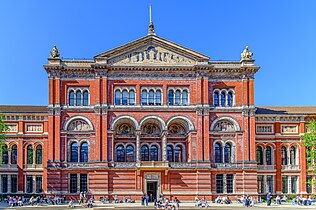
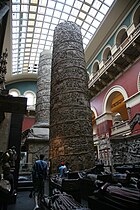































![[126]"Mantua gown made from an ivory silk brocaded in a pattern of stylised flowers and leaves."](http://upload.wikimedia.org/wikipedia/commons/thumb/c/c3/Court_mantua_dress_at_Tullie_House_Museum_A_%2824%29.JPG/120px-Court_mantua_dress_at_Tullie_House_Museum_A_%2824%29.JPG)




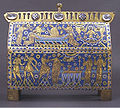












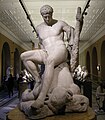
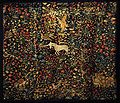

![Azerbaijani carpet "Barda" (First variant - "Chelebi"),[165] Karabakh group. 19th-century](http://upload.wikimedia.org/wikipedia/commons/thumb/3/30/Azerbaijani_carpet_%22Barda%22_%28First_variant_-_%22Chelebi%22%29_in_the_Victoria_and_Albert_Museum.jpg/96px-Azerbaijani_carpet_%22Barda%22_%28First_variant_-_%22Chelebi%22%29_in_the_Victoria_and_Albert_Museum.jpg)
